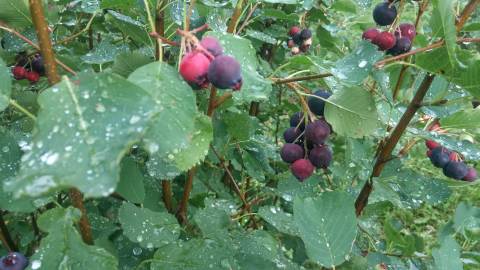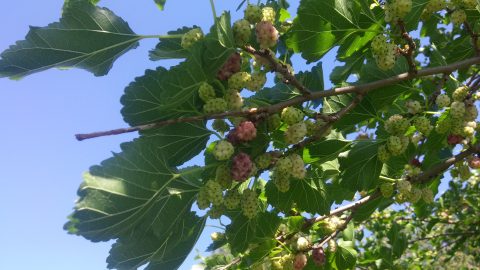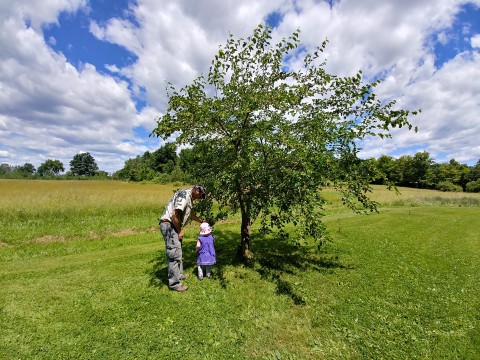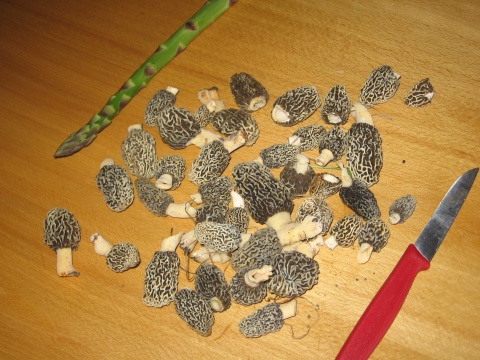Easy Pickin’s in my Saskatoon berry patch
July 12, 2019

Four years ago I ordered 20 Saskatoon berry bushes from Calgary and planted them in a disused garden plot at the farm. Nothing much has happened until this year when there were oodles of blossoms and my neighbour lent me a roll of netting to protect the fruit from the flocks of birds which follow two pairs of cedar waxwings around to the choicest eats.
Perhaps it was the soaking rains, but this week we have had a bumper crop of large, juicy Saskatoons. So far Bet has bagged and frozen seventy cups of the fruit for winter.
I am torn between wanting to believe that this wonder berry is the latest crop miracle, and/or rationalizing that it’s just the effect of too much rain which has caused the bushes to produce freakish amounts of berries, a one-year-in-a-hundred phenomenon.
I enjoy picking berries, and these grow on little trees. No uncomfortable bending is involved in the harvest. The shrubs bear exceptionally well, and the fruit can be picked in bunches if you hold a flat pan underneath to catch everything.
Saskatoons are reputed to be the best berries for pies, bar none. We’ll see. Raw, the ripe berries taste a little bland, but they are pleasantly chewy and more substantial than blueberries. Cooked, they have a more nuanced flavour and are quite nice.
UPDATE 22 JULY, 2019: I have just completed the final picking of the patch. It netted 2.25 pounds of berries after a heat wave which I expected to destroy the fruit. Unlike mulberry trees which shed ripe fruit at the first breeze, Saskatoon bushes hold onto their mature product quite well through heat and high winds.
This will put our winter cache to about 120 cups, a reasonable number if they are used each day for cereal topping, as well as other baking projects. I plan to keep a couple of pounds in the refrigerator for use fresh until late fall. They keep well.
A brief tree-hug
July 8, 2018

Then there’s the little white mulberry in my garden. It came up as a weed and I drove over it with the mower but somehow the blades missed. It bent over and avoided them. I backed up and tried again. Again I missed. So I forgot about it and went on cutting weeds around the garden. The next year it had righted itself and shot up into a little tree, though the trunk bore the scars of incredible abuse. I mowed around it. The year after that it offered a few amazingly sweet mauve mulberries to bribe me not to cut it down. O.K. Each year it has grown, self-repaired its shape, and produced more of the finest mulberries I have ever tasted. Now the garden is gone but the tree remains a source of shade and comfort.

Roz and Charlie discover real food
October 11, 2009
All summer when Roz came to the farm she would spend just enough time with us to be polite, and then she would disappear. Occasional searches would turn her up in the garden, sitting or lying in a row, plucking weeds from around her cherished plants. Roz had never been around a garden until she discovered Forfar.
So this year I involved her in the seed purchases and even put up with her desire to have green beans (too much work), peas (blow over in a good breeze), and beets (yuck!). Kohlrabi and butternut squash made it into the basket as well. Roz is very fit and relentless when it comes to work. Bet and I didn’t resist when Roz read the instructions on the seed packs and methodically planted the seeds in the rows I had laid out in the garden.
This task requires more than my personal capacity for patience and bending. Other years I would stuff a package of seeds into a seeding wheel, take aim down a row and walk until the seed gave out. This could occur anywhere from three feet in to halfway to the stake at the other end. So I’d start with another packet of something from the other end. The large gaps in the middle of the rows were ideal areas for melons to spread, so it usually worked out fairly well in my tangle. I also discovered that volunteer tomatoes look much less weedy than other weeds.
This year Roz showed up each week to check on the progress of her seeds. The rain wiped out the cucumbers, tomatoes and melons, but she lovingly tended the surviving root vegetables, communing for hours with her charges, plucking the weeds from their midst with a delicate, two-fingered grip.
And then came the harvests. The girl was so delighted with her first bowl of peas that I couldn’t rain on her parade. And she didn’t mind the work of picking the string beans. But the beets! Oh man, the beets! The rest of the folks at the table were raving about these bleeding red things, and Bet had shrewdly added some feta and garlic to the mix, so I ate a few slices. The horrible-taste memory of my childhood fell away in an instant and I very much enjoyed this new food.
After losing a war with the raccoons I vowed never again to grow sweet corn. But Roz had never had a corn patch, so we put in five rows. The raccoons struck on schedule, but Tony helped me build an electric fence around the patch. It worked. We saved the rest of the crop.
Roz remembered her garden: “I enjoyed it all far more than was reasonable. I don’t know why. I love picking raspberries. Maybe it has to do with pride in something you think you have created. Even though I know it’s cheaper to buy any of those foods than my time is worth, there’s something that makes me incredibly proud when I make a dish from ingredients that I’ve grown. I confess more than once I ate beets and raspberries until I made myself sick on them, especially the raspberries. But it’s because I enjoy collecting them so much.
“At Thanksgiving dinner in Ancaster when I told Papou* about my vegetables, my grandfather immediately insisted that we make the trip to his house to see his garden before the sun went down. He does so much. He gave us eggs, figs, pears, oregano. With the language barrier when I was a little kid I never really paid attention to him, but now I wonder if there is something hereditary in the pride he takes in his self-sufficiency, because I really enjoyed the garden and I have no idea why.”
Charlie and Martin’s syrup-making exploits last March continue to reverberate in the family as we work our way through their product. I asked Charlie what possessed him to take on such a project.
“The trees were there, and the stuff costs fifteen dollars a bottle. Roz makes me pancakes on Saturday morning and she kept sending me to buy the syrup.”
Of course Charlie and Martin had many commitments during the day so they did all of the work at night. Charlie didn’t see anything particularly unusual about that. “If you only have a two week season, odds are pretty good you’ll work most of the day on it.”
I asked him to explain the essential difference between maple syrup and corn syrup, the current nutritional public enemy #1. “Syrup is a lot more expensive and dangerous. You create it by boiling something over open flames. And inherently less is produced, so it’s less fattening. There’s also something exciting about making it.”
Roz is already making plans for next year. “I found myself thinking that the peas were more work than they’re worth, so I’ll plant more beans next year. Yesterday my grandmother dismissed rutabagas as cattle feed, but I found that you can make a rutabaga pie, and even a carrot pie. You cannot, however, make kohlrabi pie, so I think we can do with fewer of them next year and more carrots.”
*This is the simplest of five or six different spellings of the Greek term of endearment for grandfather, each of which someone on the Internet claims is correct.
Morels! (updated)
May 5, 2009
May 14th, 2009: They’re still popping up through grass and leaves. A heavy rain and a warm, south wind seems to have encouraged quite a few common morels to make themselves evident. They’re very hard to see in the grass, but Bet and I have been finding them peeking out from under cover. Of course it is tempting to move leaves and grass to find the others, but therein lies madness. Morels only grow where they want.
I read an American newspaper article one guy had on his website. It suggested confining hunting activities to newly-dead elm trees. This produced results for me today. Another point the unidentified author made was that the season continues until three consecutive 80 degree days occur. I don’t know how well that knowledge travels north. He further suggested that the season starts in mid-April in his area and moves north at a rate of 100 miles per week. http://outdoorsportsman.wordpress.com/2008/05/12/how-to-stalk-morels/
Good luck with the hunt. I think it’s at its peak now in the Eastern Ontario area.
May 5th, 2009: They’re starting! This morning I found a few tiny black morels in my favourite spot, and by late afternoon I was able to collect the group in the photo. They’re still quite small, but rain is forecast for the next three days, so they may last until the weekend in Leeds County, Eastern Ontario, Canada.
This is good.

The first pick of the year

